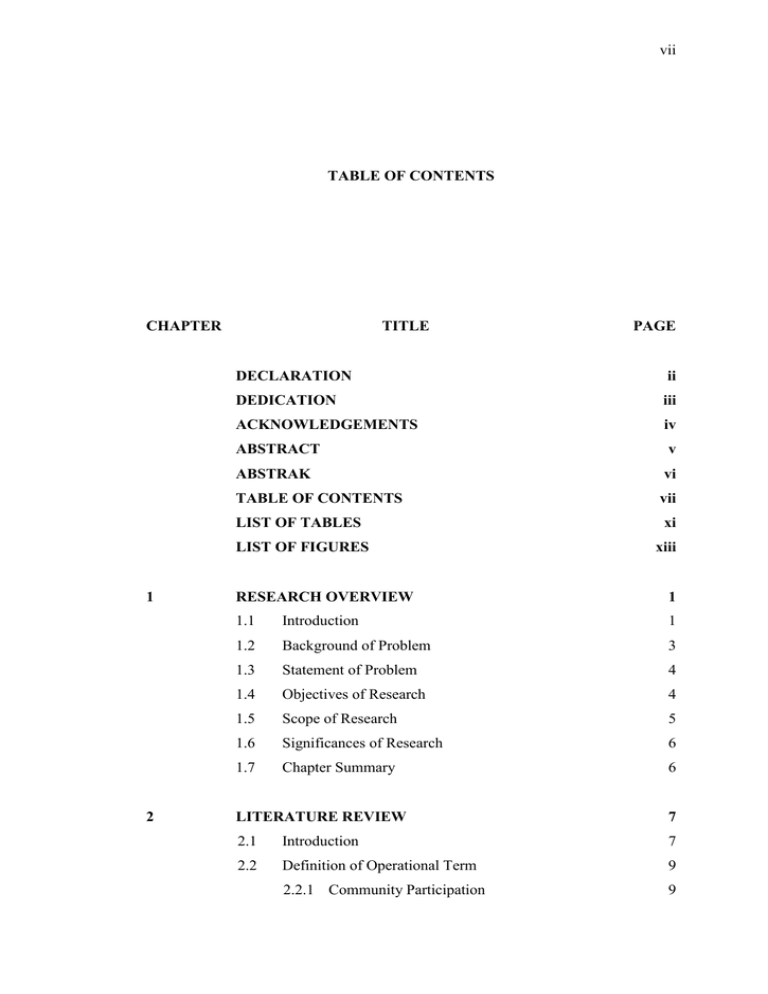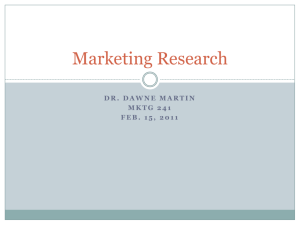vii TABLE OF CONTENTS CHAPTER TITLE
advertisement

vii TABLE OF CONTENTS CHAPTER 1 2 TITLE PAGE DECLARATION ii DEDICATION iii ACKNOWLEDGEMENTS iv ABSTRACT v ABSTRAK vi TABLE OF CONTENTS vii LIST OF TABLES xi LIST OF FIGURES xiii RESEARCH OVERVIEW 1 1.1 Introduction 1 1.2 Background of Problem 3 1.3 Statement of Problem 4 1.4 Objectives of Research 4 1.5 Scope of Research 5 1.6 Significances of Research 6 1.7 Chapter Summary 6 LITERATURE REVIEW 7 2.1 Introduction 7 2.2 Definition of Operational Term 9 2.2.1 Community Participation 9 viii 2.3 2.2.2 Cooperation 10 2.2.3 Coordination 10 2.2.4 Disaster 11 2.2.5 Emergency Action Plan 14 2.2.6 Decision Making 15 Overview of Past and Ongoing Work 17 2.3.1 Management and Diffusion of Technology for Disaster Management 17 2.3.2 A Template-based Methodology for Disaster Management Information System 19 2.3.3 Human-Computer Interaction: The Human and Computer as a Team in Emergency Management Information System 21 2.3.4 A Emergency Decision Support System based on the General Decision Process 22 2.3.5 WikiTTX: A Web Collaboration Technologybased Table Top Exercise System 24 2.3.6 Overview Summary 25 2.4 Community Behaviour during Emergency 25 2.5 Criteria that Influenced Fire Response 26 2.6 Response Regarding Fire 28 2.7 Decision Making Evaluation 29 2.7.1 Comparison of Multi-Criteria Decision Making Technique 2.8 3 Chapter Summary 31 32 METHODOLOGY 33 3.1 Introduction 33 3.2 Methodology 34 3.3 Data Collection Procedure 39 3.4 Scenario Design 44 3.5 Chapter Summary 47 ix 4 INSTRUMENTS AND DESIGN 48 4.1 Introduction 48 4.2 First Questionnaire Findings 49 4.2.1 Alternatives for Community Fire Emergency 50 4.3 4.4 4.5 5 4.2.1.1 Results of Questionnaire 51 4.2.1.2 Results of Interview 52 4.2.1.3 Summary of Findings 55 4.2.2 Criteria for Community Fire Emergency 56 4.2.2.1 Results of Questionnaire 56 4.2.2.2 Results of Interview 61 4.2.2.3 Summary of Findings 64 Second Questionnaire Findings 65 4.3.1 Criteria Weights 66 4.3.1.1 Results of Questionnaire 66 4.3.1.2 Summary of Findings 71 Third Questionnaire Findings 71 4.4.1 Alternatives Weights 72 4.4.1.1 Results of Questionnaire 72 4.4.1.2 Summary of Findings 86 Summary 86 ANALYSIS OF DATA & FINDINGS 88 5.1 Introduction 88 5.2 Community Behaviour in case of a Fire Emergency 89 5.3 Decision Tree for Community Emergency Fire 90 Response 6 5.4 Community Emergency Fire Response Framework 93 5.5 Summary 100 CONCLUSION 101 6.1 Introduction 101 6.2 Concluding Remarks 101 6.3 Limitations of the Study 103 x 6.4 Implications of the Study 103 6.5 Future Work 104 REFERENCES 105 Appendix A 109 Appendix B 110 Appendix C 111 Appendix D 114 Appendix E 118 Appendix F 126 Appendix G 127 Appendix H 128 xi LIST OF TABLES TABLE NO. TITLE PAGE 2.1 The subsequent disaster in Malaysia 14 2.2 Methodology for disaster management 19 2.3 Key elements of emergency decision processes 22 2.4 Factors affecting individual emergency reaction 27 2.5 Criteria affecting of community fire response 27 2.6 Response on the topic of fire 28 2.7 Comparisons of selection techniques for emergency action 31 3.1 Research methodology for synthesizing decision making 35 based on community emergency fire action 3.2 Saaty’s nine-point scale 42 3.3 The structure of a decision matrix for criteria weights 42 3.4 The structure of a decision matrix for alternatives weights 43 3.5 The structure of a decision matrix for priority vectors 44 3.6 Scenario design procedure 45 4.1 Number of first questionnaire distributed and returned 50 4.2 Appropriate actions for community in fire 53 4.3 Irrelevant actions for community in fire and its explanation by Mr. Md Noh Rahidin 54 4.4 Alternatives for community fire emergency 55 4.5 Critical criteria for fire emergency actions 62 xii 4.6 Criteria for community fire emergency 64 4.7 Number of second questionnaire distributed and returned 65 4.8 Decision matrix for criteria weights 70 4.9 Number of third questionnaire distributed and returned 71 4.10 Decision matrix for alternatives weights 85 4.11 Decision matrix for priority weights 87 xiii LIST OF FIGURES FIGURE NO. TITLE PAGE 2.1 Literature map 2.2 Natural disaster types in Malaysia (1968-2004) 12 2.3 Man-made disaster type in Malaysia (1968-2004) 13 2.4 Community decision making dilemmas in emergency 15 2.5 The decision making process 16 2.6 Framework for management of technology for disaster management 2.7 18 Example of generalize normative template from descriptive template 2.8 8 20 HCI design should influence all the stages of the emergency management process 21 2.9 The general decision process 23 2.10 The problem model 23 2.11 The architecture of EDSS based on general decision 23 2.12 The steps in applying a MCDM model 30 3.1 The ways of research fit disaster recovery process 38 3.2 Data collection procedure 39 3.3 Example structure of AHP 41 3.4 Steps in a generic scenario development process 45 4.1 Survey – questionnaire findings 49 xiv 4.2 Community actions taken during fire 51 4.3 Criteria that influenced community to evacuate to a place 56 4.4 Criteria that influenced community to inform family members to prepare for leaving the building 4.5 4.6 57 Criteria that influenced community to inform neighbour to prepare for leaving the building 58 Criteria that influenced community to call emergency 59 services 4.7 Criteria that influenced community to collect personal belongings 60 4.8 Prioritization of community fire emergency action 66 4.9 Comparisons of risks of human lives and criteria 67 4.10 Comparisons of instability of site and criteria 68 4.11 Comparisons of intensity of fire and criteria 68 4.12 Comparisons of intrepidity of education/ training and 69 criteria 4.13 Comparisons of information from police officer/firefighter/ aid agencies and criteria 69 4.14 Comparisons of alternatives towards risks of human lives I 73 4.15 Comparisons of alternatives towards risks of human lives 73 II 4.16 Comparisons of alternatives towards risks of human lives 74 III 4.17 Comparisons of alternatives towards risks of human lives 74 IV 4.18 Comparisons of alternatives towards instability of site I 75 4.19 Comparisons of alternatives towards instability of site II 75 4.20 Comparisons of alternatives towards instability of site III 76 4.21 Comparisons of alternatives towards instability of site IV 76 4.22 Comparisons of alternatives towards intensity of fire I 77 4.23 Comparisons of alternatives towards intensity of fire II 77 4.24 Comparisons of alternatives towards intensity of fire III 78 4.25 Comparisons of alternatives towards intensity of fire IV 78 xv 4.26 Comparisons of alternatives towards intrepidity of education/ training I 4.27 Comparisons of alternatives towards intrepidity of education/ training II 4.28 83 Comparisons of alternatives towards information from police officer/ fire-fighter/ aid agencies III 4.37 83 Comparisons of alternatives towards information from police officer/ fire-fighter/ aid agencies II 4.36 82 Comparisons of alternatives towards information from police officer/ fire-fighter/ aid agencies I 4.35 82 Comparisons of alternatives towards influence of environment IV 4.34 81 Comparisons of alternatives towards influence of environment III 4.33 81 Comparisons of alternatives towards influence of environment II 4.32 80 Comparisons of alternatives towards influence of environment I 4.31 80 Comparisons of alternatives towards intrepidity of education/ training IV 4.30 79 Comparisons of alternatives towards intrepidity of education/ training III 4.29 79 84 Comparisons of alternatives towards information from police officer/ fire-fighter/ aid agencies IV 84 5.1 Behaviour of community in fire emergency 89 5.2 Decision tree for community emergency fire decision 92 making 5.3 The importance of knowledge VS training 97 5.4 Framework for community emergency fire response 99



